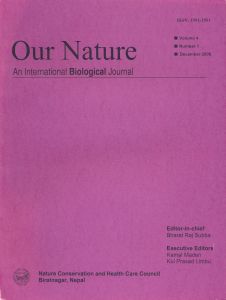An Overview of Floral Diversity in Wetlands of Terai Region of Nepal
DOI:
https://doi.org/10.3126/on.v4i1.506Keywords:
Flora, Ghodagodi, Koshi Tappu, Terai, WetlandsAbstract
Based on altitudinal variations, Nepal is divided into 7 physiographic zones. The southern lowland constitutes the Terai zone (below 300m) and is a part of alluvial Gangetic plain lying between the Indian border and the outer foothills (Siwaliks). Biogeographically, the area falls in the Indo-Malayan region and is characterized by tropical climate. The area is rich in floral diversity and contains about 1885 species of vascular plants. However, a detail inventory is yet to be prepared. The region also houses a number of habitats such as wetlands, croplands, grasslands, forests, riverine floodplains and so on. Terai is an important area for wetland habitat where exists 80 natural lakes, 55 important floodplains, 12 marshes as well as reservoirs and canals. In addition, there are several rivers/streams, seasonally flooded grasslands, rice fields and man made aqua-cultural ponds. The present paper highlights wetland dependent endemics, threatened plant species, and also gives an overview about the species composition, habitat wise distribution, uses and threats. Attention has been given to focus the Koshi Tappu and Ghodaghodi wetlands.
Keywords: Flora, Ghodagodi, Koshi Tappu, Terai, Wetlands
doi:10.3126/on.v4i1.506
Our Nature Vol. 4(1) 2006 pp83-90
Downloads
2329
6357




